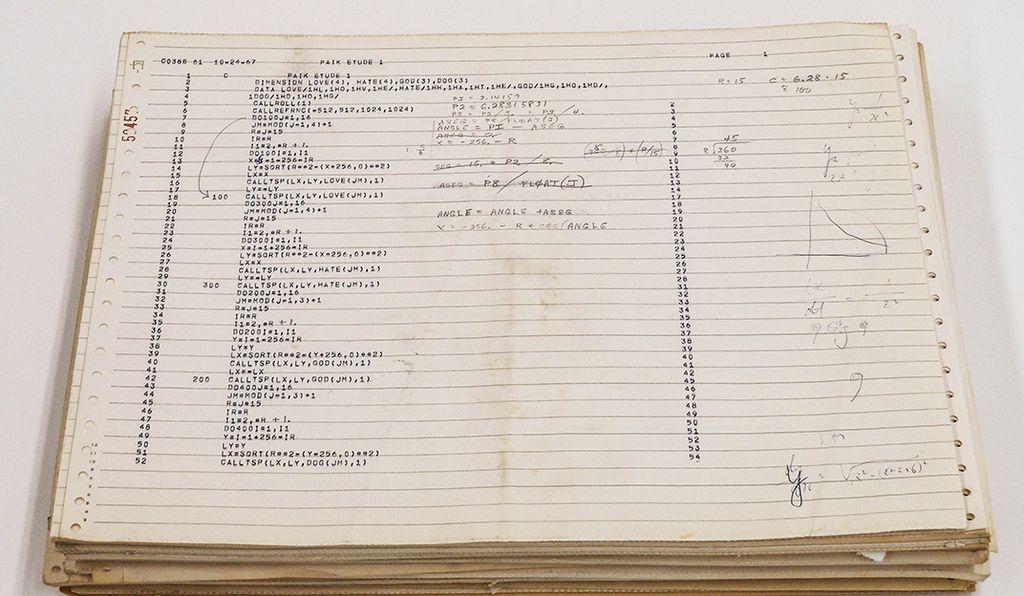
This blog post is adapted from an essay written by Michael Mansfield, curator of film and media arts, to accompany the exhibition, Watch This! Revelations in Media Art, opening April 24 and running through September 7.
In 1964, Marshall McLuhan wrote that artists were the only people able to "encounter technology with impunity," suggesting that they would be fearless in their approach, unafraid of the consequences, and could light the way for the rest of us. The stunning range of artistic engagements with technology in the last 70 years certainly supports this theory. The twentieth century introduced hi-fidelity stereo, broadcast television, videotape, orbital satellites and computer systems, each one touched by artists in one fashion or another and providing a pretty fantastic index to the changes in our cultural perceptions.
Perhaps one of the more dramatic introductions has been in computing. Today, we encounter computers on a daily basis without giving it much thought. For many of us it is on a minute-to-minute basis. But not so long ago, coming upon a computer was a rare event. They were novel machines. And for the average person, they were pretty foreign. Computers were primarily linked to the government and the military, making them even more mysterious. The ENIAC machine, the first electronic computer system, was created in the mid-1940s to calculate firing tables for artillery. Mainframe computers and the languages articulated for them were the invention of research centers largely funded by the United States Army and the Pentagon. Before long, the Department of Defense began developing ARPANET as a means to decentralize authority and safeguard information in response to geopolitical tensions with the Soviet Union during the cold war. But the computer's practical and creative potentials were immediately fragmented, co-opted by both play and politics. Computer code was written for videogames such as Alan Turing's computer chess programs in the late 1940s and 1950s, and employed to predict democratic elections, like Dwight D. Eisenhower's 1952 presidential victory. Commercial companies soon began funding research labs that paired engineers with artists to encourage experimentation and stretch these new inventions. So, even while military computers envisioned triggering a nuclear apocalypse, artists were envisioning an alternative, or in the least, a more human application.
Nam June Paik arrived to New York as an immigrant in 1964. He had recently completed his studies in music and had become an enthusiastic champion of technology and electronics for use in performances and art making. New York offered rich territory in the communications industries, ground ripe with new technologies. At the time, an experimental venture in New Jersey between the Western Electric Company and the American Telephone and Telegraph Company (AT&T) founded Bell Telephone Laboratories, Incorporated. More commonly referred to as "Bell Labs," the venture was pioneering research into human computer uses in art and devoting valuable time on their mammoth GE600 computer for artists to explore sound, animation and stereoscopic vision. Bell Labs had seated several artists like Michael Noll, Laurie Spiegel, Lillian Schwartz and Stan VanDerBeek, working both independently and collaboratively. It was a hotbed of experimental art.
Paik had previously studied western music in both Japan and Western Europe before moving to the United States. He had been formally trained in the arrangement of orchestral scores, actions in a script, and instrumentation. They were programs. The practical and conceptual relationships between compositions for music and code for computer programs are sound, so to speak. In 1966, Paik was invited to Bell Labs and introduced to FORTRAN computer programming by James Tenney and Michael Noll. He was well prepared and by 1967 Paik was a "Resident Visitor".
In his research at Bell Labs, Paik produced videos, graphics, computer punch cards, negatives and continuous feed printouts, all compiled from the FORTRAN programming language. Three distinct programs leading to computer-generated media reveal his work with both moving and static images. Digital Experiment at Bell Labs is a starkly minimal video recording of the computer screen, marking a gesture toward the origins of computer imaging. A second piece is Confused Rain (1967), a computer generated print that results from randomly placed letters spelling out C O N F U S E, suggesting a "mix of real rain and simulated rain in the computer." The third complete work is ETUDE, a previously unknown computer composition from 1968. In ETUDE, Paik wrote a computer program to create four concentric, intersecting circles displaying the somewhat irreverent text LOVE HATE GOD DOG, each repeating word composing its own diameter. These are sophisticated programs by Paik, and such prominent use of type, text and lettering in his explorations is significant. It relates not only to Paik's experience scripting Fluxus performances or the work of his contemporaries John Cage, Yoko Ono and Ray Johnson, it corresponds with his want of a poetic alternative to the ordered structure of the programming language itself. Such emotional binaries as "love" and "hate," or disparate phonetic games like "god" and "dog," while certainly Fluxus absurdities, also input a human-ness to the machine. It whimsically described Paik's relationship to the world around him in 1968 —in human readable terms— and invoked the symbolic codes invested in these novel, man made machines.
While in residence at Bell Labs, Paik wrote in a letter, "it is my ambition to create the first computer-opera in music history." Though Paik would abandon his work in FORTRAN shortly after these works were realized, that ambition remains an eloquent reminder of his interests in the human nature of technology that he strived so hard to reveal. And elements of this inspiration —the coexistence of humankind with the ingenious things humans make— would remain key threads throughout his artistic practice.




















